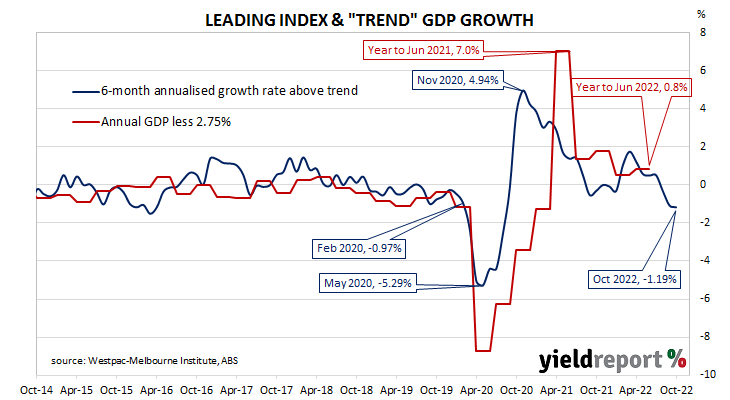Summary: Leading index growth rate down again in September; further support for forecasts of substantially slower growth in 2023; reading implies annual GDP growth of around 1.50%; ACGB yields mostly lower; rate-rise expectations firm; “sharp turnaround” from April attributed to higher interest rates, lower prices for commodities in AUD terms, slowing of “hours worked” growth.
Westpac and the Melbourne Institute describe their Leading Index as a composite measure which attempts to estimate the likely pace of Australian economic growth in the short-term. After reaching a peak in early 2018, the index trended lower through 2018 and 2019 before plunging to recessionary levels in the second quarter of 2020. Subsequent readings spiked towards the end of 2020 but then trended lower through 2021 and 2022.
The October reading of the six month annualised growth rate of the indicator registered -1.19%, down from September’s figure of -1.09% after it was revised from -1.15%.
“As the growth rate continues to fall, albeit at a much slower pace than we saw last month, we continue to get further support from the Leading Index that growth will slow substantially in 2023,” said Westpac Chief Economist Bill Evans.
Index figures represent rates relative to “trend” GDP growth, which is generally thought to be around 2.75% per annum in Australia. The index is said to lead GDP by “three to nine months into the future” but the highest correlation between the index and actual GDP figures occurs with a three-month lead. The current reading thus represents an annual GDP growth rate of around 1.50% at the end of the December quarter.
Domestic Treasury bond yields mostly moved lower on the day following noticeable falls of US Treasury yields overnight. By the close of business, 3-year and 10-year ACGB yields had both lost 4bps to 3.29% and 3.73% respectively while the 20-year yield finished 1bp higher at 4.20%.
In the cash futures market, expectations regarding future rate rises firmed. At the end of the day, contracts implied the cash rate would rise from the current rate of 2.81% to average 2.97% in December and then increase to an average of 3.185% in February. May 2023 contracts implied a 3.62% average cash rate while August 2023 contracts implied 3.79%.
Evans noted the “sharp turnaround” from April’s reading of 1.19 to -1.19 to this latest reading. He attributed higher short-term interest rates, lower prices for commodities in Aussie dollar terms and a slowing of the “hours worked” growth rate as the main contributors to the change over the six month period.


